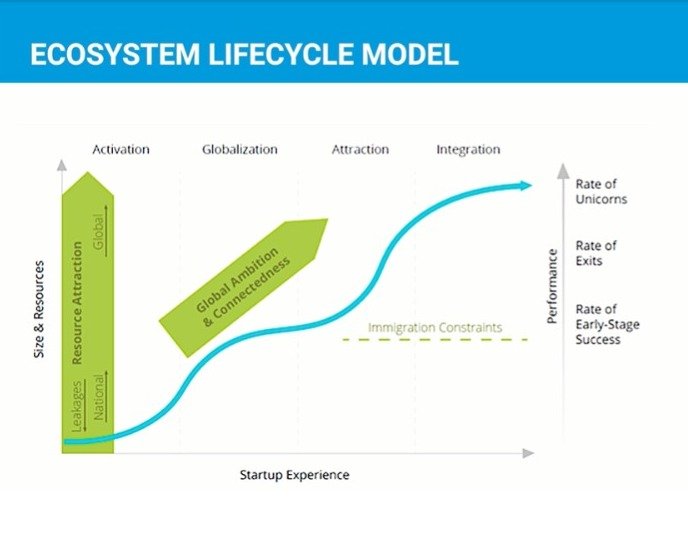Introduction
Start-ups are key generators of innovation and economic progress. But what favours the emergence and growth of these enterprises? It is certainly true that growth- and innovation-oriented entrepreneurship is influenced by national conditions, but the drivers go far beyond that.
Definition of ecosystem
To define the innovation ecosystem, it is necessary to start with three components and combine them to fully understand its meaning: innovation, system and ecosystem.
The concept of innovation has a long conceptual history with many connotations and fluid denotations, but can be summarised as the result of a process leading to a degree of novelty due to a change and a degree of usefulness or success in the application of something new.
The concept of ecosystem originates in the field of ecology and is defined as a dynamic community that co-evolves, composed of different actors who create and capture new value through competitive and collaborative interaction mechanisms.
Hence theinnovation ecosystem is the evolving set of actors (firms, private organisations, government entities), activities and artefacts (products/services/technologies), institutions (policies, regulations) and their relationships, which combine together to achieve a comprehensive value proposition for the entire ecosystem (Adner, 2017). Under this logic, ecosystems enable value creation that no single firm could create alone.
Basic principles
Adopting an ecosystem approach to innovation therefore recognises that:
- An innovation ecosystem consists of different actors, reports (non-causal) and resources capable of turning an innovative idea into transformative impact on a large scale.
- L'effectiveness of each party within the ecosystem is influenced by the other parties (e.g. entrepreneurs depend on being able to access finance).
- The change in one part of the ecosystem leads to changes in other parts of the ecosystem, creating strong interdependence between the parts (e.g. increased Internet connectivity will accelerate the design and testing of new technologies).

The evolutionary stages of the innovation ecosystem
Innovation ecosystems and entrepreneurship can be represented through a life cycle consisting of four phases, each identifiable by a different set of features, challenges and objectives.
The first phase of activation is characterised by limited start-up experience in terms of knowledge of entrepreneurs, experienced investors, advisors and mentors, and community behaviour that can support the success of young companies. The objective of this phase must therefore be to define targeted programmes aimed at increasing entrepreneurial mindsets, growing a sense of local community to create connections between actors, and expanding the contribution of dedicated forms of financing to provide capital for embryonic enterprises.
In the phase of globalisation there is more experience in starting up entrepreneurial initiatives and a series of Trigger (entrepreneurial experiences acting as triggers) with wide resonance that lead to the attraction of national resources (entrepreneurs, talent, investors) from other ecosystems that are going through the previous phase, but are looking to global ecosystems. It is therefore necessary to focus on increasing the connection, with the founders of the best ecosystems, which is the success factor defining the scalability potential of an ecosystem, and on (financial) support for start-ups that can increase their initial presence in the global market.
In the phase of attraction increases the number of success stories globally, in some cases forming unicorn companies with outputs in excess of $1 billion, producing aglobal attraction for additional resources. At this stage, it is necessary to leverage these resources to significantly expand the size of the ecosystem, fill remaining gaps and direct the attraction through well-designed policy programmes.
In the final phase of integration the ecosystem becomes self-sustainable with a strong global connection and knowledge flow within the ecosystem that keeps its companies integrated into the global fabric and is able to produce cutting-edge business models and skills necessary to achieve a high global level. In order to stably and sustainably integrate the ecosystem within global, national and local flows of resources and knowledge, it is necessary to optimise the political laws to support the competitiveness and growth of the ecosystem and spread the benefits (culture, source of competitiveness, capital, innovation) to other sectors of the economy and parts of the nation.
The evaluation of innovation ecosystems
As indicated by Michael Porter with reference to traditional sectors, the size of an ecosystem has a major influence on its performance. This happens thanks to a series of network effects such that the economic impact of each additional innovative enterprise within the ecosystem grows as the size of the ecosystem increases.
The same is true for the innovation ecosystem, as shown by research carried out by the Startup Genome1. According to this study, in an ecosystem of 1,000 start-ups, each start-up adds on average one value of $5.1 million in economic value, in an ecosystem of 2,000 start-ups each start-up adds $6.9 million, in one of 3,000 start-ups the value of each increases to $10.6 million, and so on. Using a summary rule of thumb we can say that ecosystems 3 times larger produce 5 times greater economic valueexponential growth of a factor of 1.7. Similarly, an ecosystem that loses half of their companies could lose more than half of economic value previously created. From this simple analysis, one can understand the importance of creating and maintaining viable innovation ecosystems.
1 Startup Genome is the research organisation and policy advisor world-leading public and private agencies committed to accelerating the success of their start-up ecosystem.







